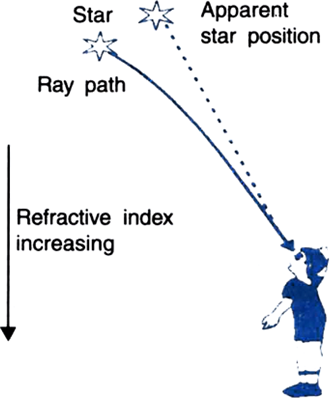 Short Answer Type
Short Answer TypeName the scientist who first of all showed that an atomic number of an element is a more fundamental property than its atomic mass.
A student is unable to see clearly the words written on the black board placed at a distance of approximately 3 m from him. Name the defect of vision the boy is suffering from. State the possible causes of this defect and explain the method of correcting it
Why do stars twinkle? Explain.
The twinkling effect of the star is due to the phenomenon of atmospheric refraction. On entering the surface of the earth, the starlight undergoes continuous refraction in a medium which undergoes a gradual change in the refractive index.
The atmosphere bends starlight towards the normal so, the apparent position of the star is slightly different from its actual position. When viewed near the horizon, the position of the star appears slightly raised.
Since the physical conditions of the earth's atmosphere are not stationary, the apparent position of the star keeps on changing slightly.
The stars are very distant and they appear as point-sized sources of light. As the path of rays of light coming from the star is continuously varying, the apparent position of the star fluctuates and the amount of starlight entring our eye flickers. The star sometimes appears bright and sometimes faint. This is known as the twinkling effect of stars.

The apparent position of star due to atmospheric refraction.
Write the function of each of the following parts of the human eye :
(i) Cornea
(ii) Iris
(iii) Crystalline lens
(iv) Ciliary muscles
Why does the sun appear reddish early in the morning? Will this phenomenon be observed by an astronaut on the Moon ? Give reason to justify your answer
Name the process by which an amoeba reproduces. Draw the various stages of its reproduction in a proper sequence
A student is viewing under a microscope a permanent slide showing various stages of asexual reproduction by budding in yeast. Draw diagrams of what he observes. (in proper sequence)
An object of height 4.0 em is placed at a distance of 30 cm from the optical centre ‘O’ of a convex lens of focal length 20 cm. Draw a ray diagram to find the position and size of the image formed. Mark optical centre ‘O’ and principal focus ‘F’ on the diagram. Also find the approximate ratio of the size of the image to the size of the object.
A student added few pieces of aluminium metal to two test tubes A and B containing aqueous solutions of iron sulphate and copper sulphate. In the second part of her experiment, she added iron metal to another test tubes C and D containing aqueous solutions of aluminium sulphate and copper sulphate.
In which test tube or test tubes will she observe colour change ? On the basis of this experiment, state which one is the most reactive metal and why.
